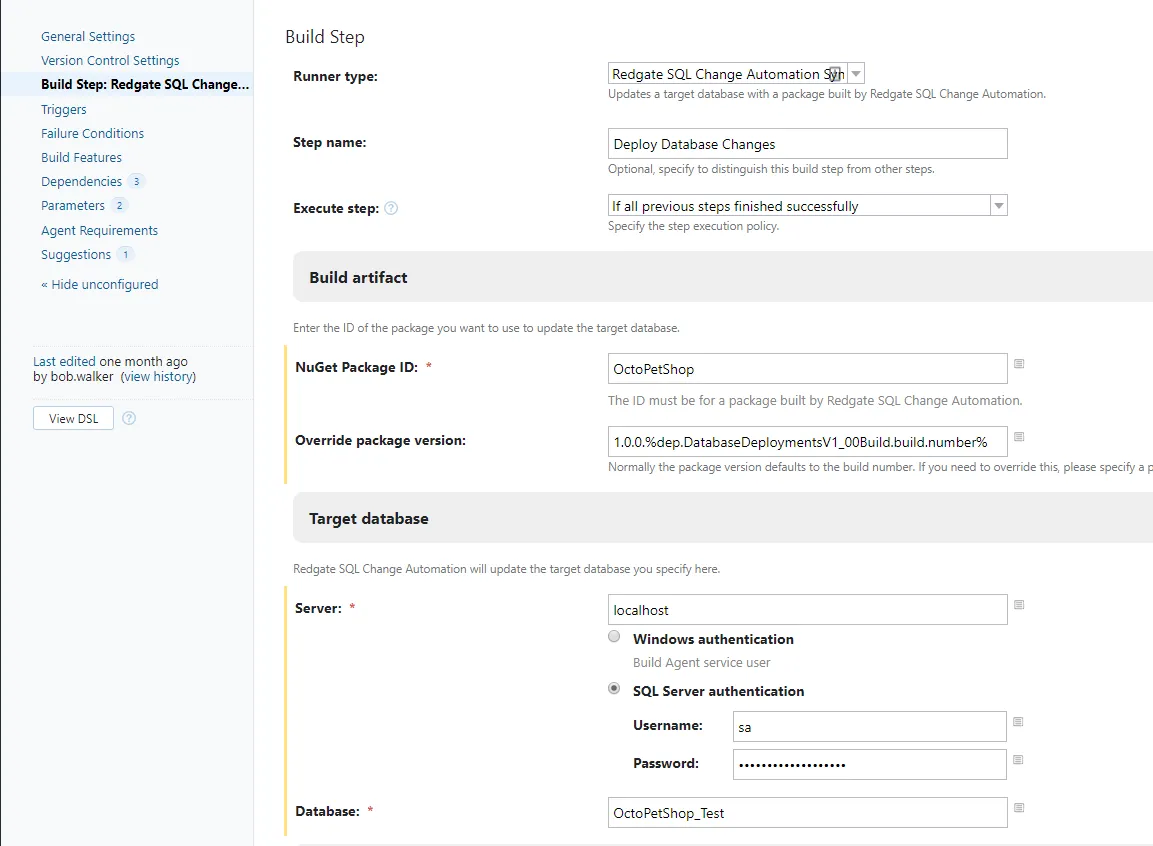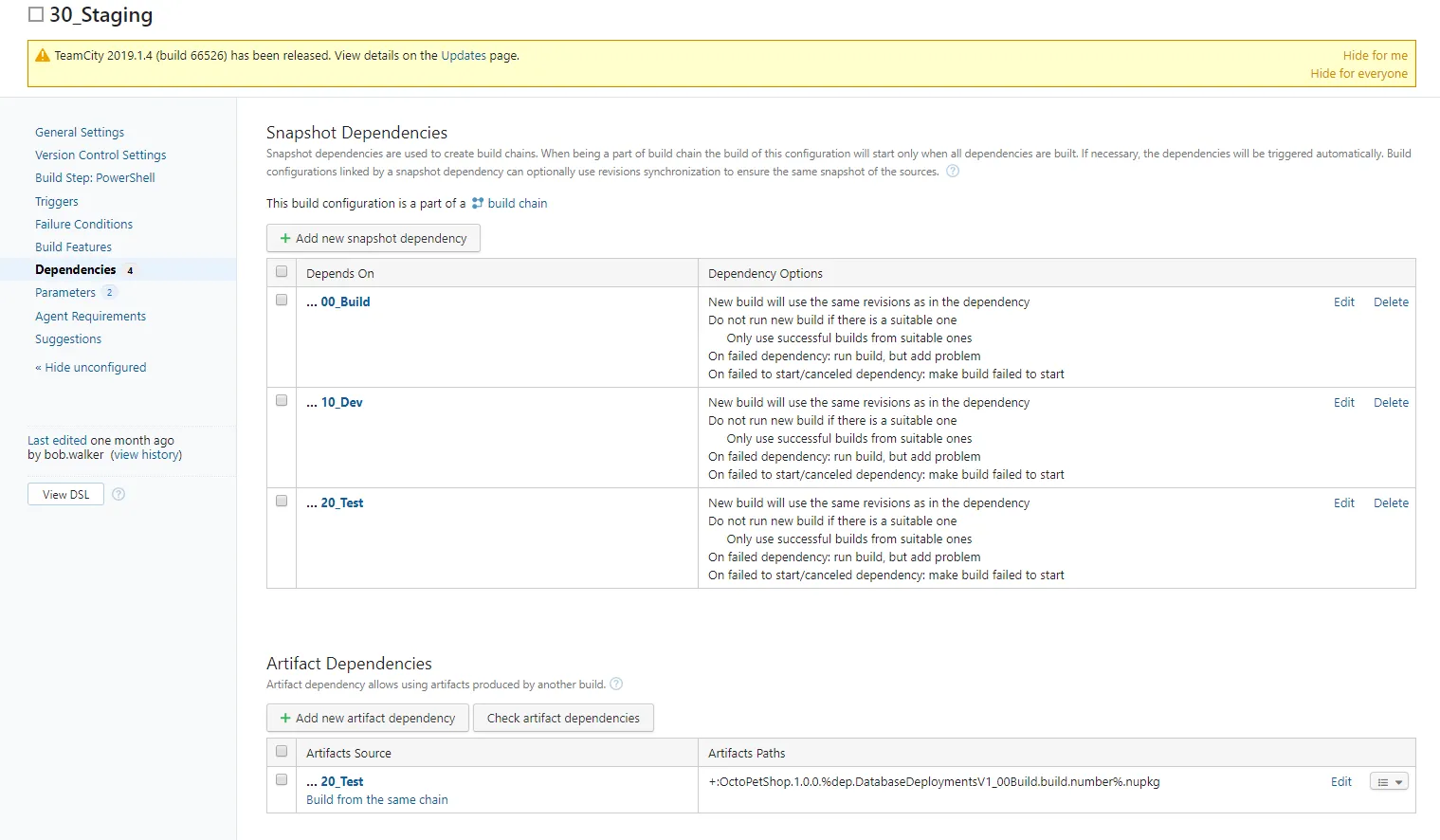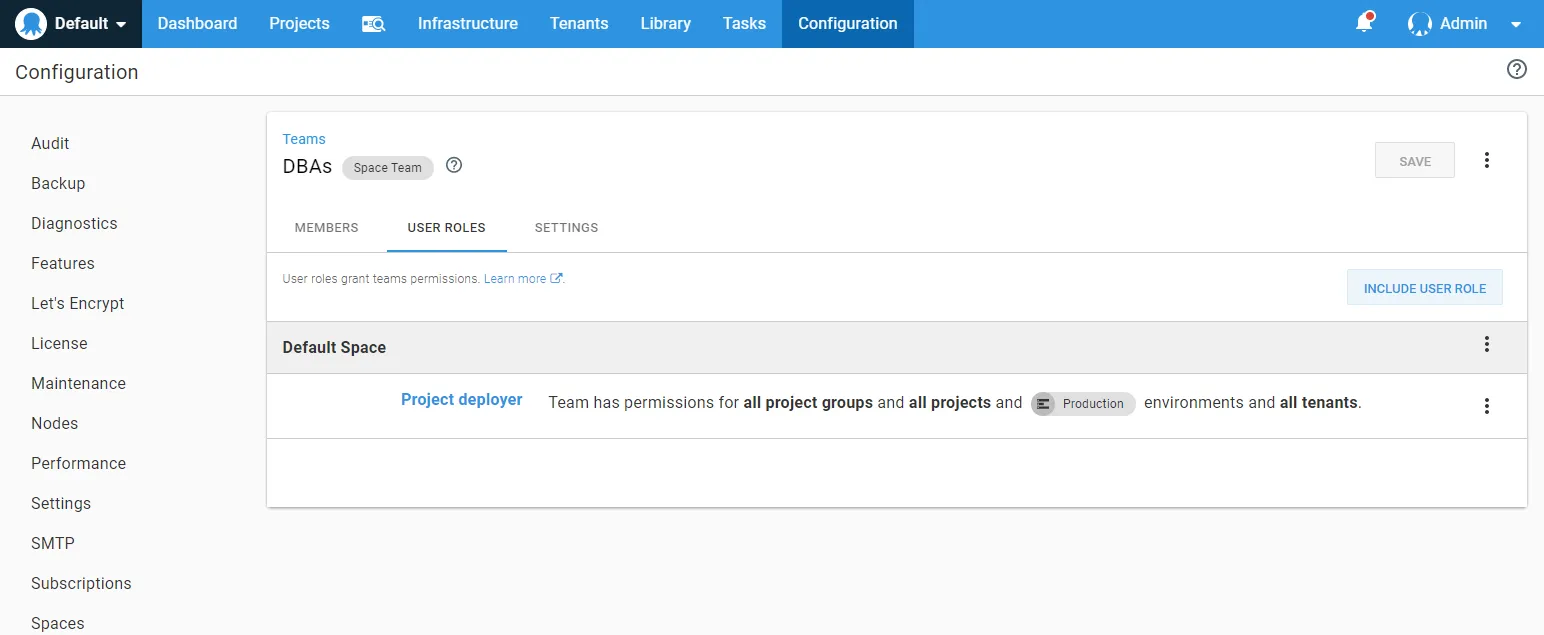It took several iterations to implement the ideal automated database deployment process using TeamCity, Redgate, and Octopus Deploy. I focused on how to automate deployment for SQL Server but the lessons are applicable to other database and tools as well. The iterations were a result of learning the tooling and listening to feedback. In this article, I walk you through a couple of those iterations of the automated database deployment process.
This article is the final in a series. Here are the links to the other articles, in case you missed them.
- How to design an automated database deployment process.
- Automated database deployment process: case study.
All of our database deployment articles can be found here.
General overview
All this work was done at a company I previously worked for. That company had four environments.
- Development
- Test
- Staging
- Production
Developers, database developers, and lead developers all had sysadmin rights for development and test. They had read-only rights for staging and production. Only the DBAs had sysadmin rights to all environments.
Prior to automated database deployments, a our process was:
- A developer makes a database change in
test. All developers have sysadmin rights intest. They should make the change indevelopmentbuttesthas all the data to verify the change with. That is the server their code is pointed to. - The developer changes the connection in SSMS and makes a change to
development. All developers have sysadmin rights indevelopment. - The database developer or lead developer runs Redgate SQL Compare to generate a delta script between
testandstaging. Any complex database changes (move columns, combine columns, etc.) are removed and manually scripted. Scripts are saved to a shared folder. Everyone except DBAs have read-only rights forstaging. The DBAs have to run the scripts. - DBAs are notified via email to run scripts in the shared folder on
staging. They run the scripts and send the output to the requester. - Multiple database changes can be pushed to
stagingprior to going toproduction. Because of that, a new Redgate SQL Compare delta script betweenstagingandproductionis generated by the database developer or lead developer. Just like before, any complex database changes (move columns, combine columns, etc.) are removed and manually scripted. Scripts are saved to a shared folder. Everyone except DBAs have read-only rights forproduction. - DBAs are notified via a change request to run a set of scripts in
production. They run the scripts, save the results to the change request system, which emails the requester.
There were several flaws in this process.
- Multiple deployment processes, how changes were deployed to
developmentandtestwas different tostagingandproduction. - Manual generation of scripts.
- Manually running each script in each environment.
- Unique delta scripts per environment.
- Unique delta scripts meant it was difficult or nearly impossible to test.
- No mention of keeping track of changes and what needed to be deployed.
- Shared development environment.
- Reviews didn’t happen until it was time to go to
staging. - As a result, “All hands on deck” during
productiondeployments.
At this point, the tooling we used was:
- Git was being piloted as a replacement for TFS Version Control.
- TeamCity was being piloted as a replacement to TFS 2012.
- No deployment server.
- No database deployment tools (this is where Redgate’s tooling came in).
Automated database deployments v1
When you have a hammer, everything looks like a nail. As detailed in my previous article, I first set about automating within the existing process. That above process, or some form of it, was all I knew up until that point.
My focus was:
- Force everyone to make database changes in
developmentand automatically deploy totest. - Automatically generating the delta script for
stagingandproduction.
Ideally we would automatically deploy to staging and production. That would require the build server, in this case TeamCity, run an agent with permissions in those environments. The DBAs made made it very clear, TeamCity would not have permission to deploy to staging or production.
I already had TeamCity building the code. I needed to inject the database into that existing build process. Redgate provides a plug-in for TeamCity. Looking at the documentation for Redgate’s TeamCity Plug-in shows it supports three functions:
- Build a package.
- Sync that package with a database.
- Test that package.
For the build a package process to work, the database has to be placed into source control using Redgate’s SQL Source Control. Prior to putting the database into source control I should have resolved the deltas between each environment. Different users and role membership are expected. Missing tables, different stored procedures, and other schema changes, not so much.
The deltas need to be resolved one of three ways:
- If the change was simply missed, go ahead and apply it.
- If the change is intentional and should never be included in source control (backup table or testing table), you can leverage filters to exclude those items.
- If the difference is environmental, such as users and role membership, you will need to look at the documentation to see which switches you need to include.
The final piece of the puzzle is auto generating the delta script. Thankfully, Redgate has a CLI version of their schema compare tool.
Knowing that, my plan of attack was:
- Resolve all the deltas.
- Put what is in
developmentinto source control. Going forward, all database changes must be made indevelopmentand checked into source control. - Have TeamCity build the package from source control.
- Have TeamCity sync that package with
development. - Have TeamCity sync that package with
test. - Have TeamCity run the schema compare CLI to generate delta scripts for
stagingandproduction.
Steps 1 and 3 conflict with each other. So let’s skip that step.
- Resolve all the deltas.
- Put what is in
developmentinto source control. Going forward, all database changes must be made indevelopmentand checked into source control. - Have TeamCity build the package from source control.
Have TeamCity sync that package withdevelopment.- Have TeamCity sync that package with
test. - Have TeamCity run the schema compare CLI to generate delta scripts for
stagingandproduction.
I’m not going to walk through how to put a database into source control. I wrote that article already.
I ended up with four TeamCity projects.

The 00_Build project takes what is in source control and packages it.

I am making use of TeamCity’s snapshot dependencies and artifact dependencies. To leverage that, I need to mark the package created as an artifact.

10_Dev and 20_Test follow the same process. First, I needed to configure the dependencies on the build. The dependencies include the snapshot dependencies and artifact dependencies.

Now that I have the package and the dependency configured, I can add the step to sync the test database with the package. Please note, to deploy the latest package, I am overriding the build number using the value from the 00_Build project.

The 30_Staging build is very different. First, I configure the dependencies just like before.

Instead of running the sync step, it runs a PowerShell script to generate the delta scripts for staging and production.

Flaws with automated database deployments v1
Let’s revisit the flaws with the existing process and see how we are doing after this effort.
There were several flaws in this process.
- Two different processes, one for
developmentandtest, and another with slight differences forstagingandproduction. This is still happening. - Manual generation of scripts. Solved.
- Manual running of each script in each environment. This is solved for
testonly. - Unique delta scripts per environment. This is still happening
- Unique delta scripts meant it was difficult or nearly impossible to test. This is still happening
- No mention of keeping track of changes and what needed to be deployed. Solved.
- Shared development environment. This is still happening
- Reviews didn’t happen until it was time to go to
staging. This is still happening - As a result, “All hands on deck” during
productiondeployments. This is less of a problem, but is still happening
Also, I introduced a couple of new problems.
- Hours or days between when a script is generated by
30_Stagingand when it was run instagingorproduction. - Hard to know what version is going to be used to generate the delta scripts when
30_Stagingran. - The latest changes only, you can’t pick an older version.
New process
In my previous article, I discussed how Redgate helped a work group at the company I was working for. Let’s review the process we came up with.
- A developer/database developer/lead developer creates a branch.
- All database changes and code changes are made on that branch.
- Changes are completed and checked into the branch.
- A merge request is created, which kicks off a build. The build verifies the changes are valid SQL.
- The database developer or lead developer reviews database changes in the merge request and provides feedback for fixes.
- The branch is approved and merged.
- The build server kicks off a build, verifies the changes are valid SQL, and if they are, packages them and pushes to the deployment server. The build server tells the deployment server to deploy to
development. - The deployment server deploys to
development. - A developer/database developer/lead developer tells the deployment server to deploy to
test. - The deployment server deploys to
test. - Database changes are verified in
test. - A developer/database developer/lead developer tells the deployment server to deploy to
staging. The deployment server uses database tooling to generate the review script. - The deployment server notifies the DBA of the deployment request to
staging. They review the changes and provide feedback for fixes. - DBAs approve changes to
staging. - The deployment server finishes deployment to
staging. - Database changes are verified in
staging. - A change request is submitted to the DBAs to promote a specific package in the deployment server to
production. - After hours, DBAs tell the deployment server to deploy to
production. The deployment server uses database tooling to generate the review script. - DBAs review the script as a final sanity check.
- The deployment server finishes deployment to
production.
The next iteration of the automated database deployment process would implement that.
Automated database deployments v2
Octopus Deploy was added to v2 of automated database deployments. This was the deployment server we didn’t know we needed. Having a deployment server enabled us to:
- Simplify TeamCity, it only had to build and push a package to Octopus Deploy.
- Use the same process and tooling in all environments.
- Have an audit history of when a database change went out. Not only that, it provides the ability to know who deployed the change.
TeamCity was simplified to two projects.

00_Build would build the package just like before. 10_Dev pushes that package and triggers a deployment in Octopus Deploy to development. Our documentation does an excellent job of showing you how to do that.

After a bit of trial and error, the deployment process in Octopus Deploy became this:

The trial and error was around steps 1 and 4 in that process. At first, I ran the same CLI script from TeamCity to generate the delta script to review. That wasn’t the same as what was being deployed. Eventually, I learned about the Create Database Release and Deploy from Database Release step templates provided by Redgate.
Using the Redgate provided step templates automatically generated and uploaded the delta scripts as Octopus Artifacts. DBAs could then download those files and review them when they were approving the deployment to staging or production.

Following this process, the DBAs were more than happy to let Octopus deploy to staging and production. They could review the scripts during the deployment, and who reviewed the scripts was audited. Besides, they were happy to see all it took was pushing a button. As one DBA put it, “this is all stupid simple.”
What sealed the deal was the ability to control who could push the deployment button. All developers (including database developers and lead developers) could deploy to development, test, and staging.

While the DBAs could deploy to production, they didn’t have the right to change the deployment process, only developers could do that.

While developers could deploy to staging, the DBAs were the ones who approved the changes.

These security policies and manual interventions built a lot of trust in the process.
Flaws with automated database deployments v2
Let’s check back in with our issue list.
- Two different processes, one for
developmentandtest, and another with slight differences forstagingandproduction. Solved. - Manual generation of scripts. Solved.
- Manual running of each script in each environment. Solved.
- Unique delta scripts per environment. Mitigated, this is how the tool works.
- Unique delta scripts meant it was difficult or nearly impossible to test. Mitigated but much less chance of causing errors since the same process is used.
- No mention of keeping track of changes and what needed to be deployed. Solved.
- Shared development environment. Solved.
- Reviews didn’t happen until it was time to go to
staging. Solved., database developers reviewed feature branch changes, and DBAs reviewed instaging. As a result, “All hands on deck” duringproductiondeployments. Solved. - Hours or days between when a script is generated by
30_Stagingand when it was run instagingorproduction. Solved. - Hard to know what version is going to be used to generate the delta scripts when
30_Stagingran. Solved. - The latest changes only, you can’t pick an older version. Solved.
Fantastic, all the original problems, plus the problems with v1, were solved or mitigated. But something interesting happened. The process worked, and as the weeks went by, we started doing more and more deployments to production and staging.
- As the process was written, the DBAs had to be online during each
productiondeployment. - Developers had to wait until the DBAs finished reviewing their scripts in
stagingprior to deployment. The DBAs couldn’t keep up. - There was no test data in the developer’s local databases; this resulted in them pushing unfinished changes to
test. They’d then point their code totestso they had data to test with.
Automated database deployments v2.1
The work group met, and we agreed to make the following changes to the process:
- DBAs will only approve changes in
staging. - Approval in
stagingwill occur after the deployment occurs. - DBAs only want to be notified if deployment to
productionfails. - DBAs want to see the delta script for
productionduring the staging deployment. It won’t be 100% the same, but it will be close enough for them to review. The actualproductiondeployment script will be created during theproductiondeployment and saved as an artifact. - Generate a backup of
testafter each deployment. Developers could then restore the backup on their instance to get the testing data.
The resulting process looked like this:

After those changes were in place, DBAs could leverage the Deploy Later functionality in Octopus Deploy. They no longer had to be online for each deployment to production.

Conclusion
After going through this process, deployments to production became a non-event. The DBAs only had to jump online during production deployments when something failed, which became rarer and rarer, but it took several iterations to get there.
What surprised me the most was how much everything changed from start to finish. I’ll be honest; if I came across a customer with that final database deployment process, I’d have a lot of questions. But it makes sense in the context of the company that implemented it. It meets their requirements. Don’t be surprised by the number of iterations you make and where you will eventually end up. Every company is different.
Happy Deployments!
If you enjoyed this article, great news, we have a whole series on automated database deployments.
Related posts

Octopus Cloud architecture
Learn how cell-based architecture helped us make Octopus Cloud reliable and scalable.

Solutions engineer - the jack of all trades
Learn why being a jack of all trades is great when you're a solutions engineer.

How to bulk update the execution container image
Learn how to use an API script to update the image used for execution containers in deployment processes and runbooks.



